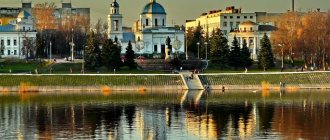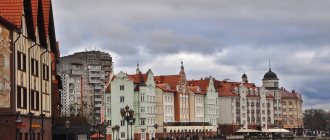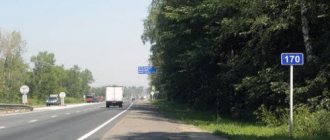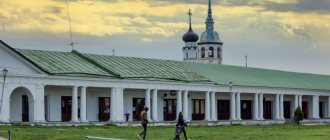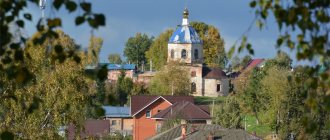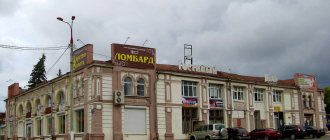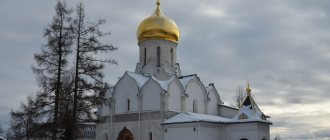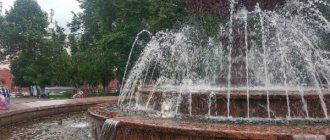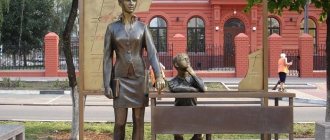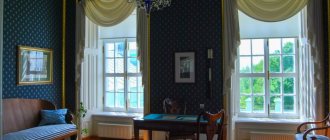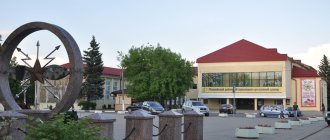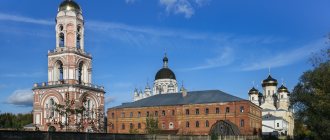The charm of the Russian province, seasoned with a rich historical past. This mix awaits everyone who decides to go to Tver. This cute and cozy town on the banks of the Volga will not be a revelation for those who are accustomed to template excursions and standard routes. Tver needs to be studied more carefully to see everything that its more than 10-century history hides. The first mentions of the city date back to the 12th-13th centuries. More precisely, the charter states that the year is 1135, and the chronicle indicates the year 1208. It turns out that Tver is older than Moscow. This fact gave historians a reason for jokes, such as the fact that the future capital still stood as a village in the swamps, but by that time a real city was already located here.
- Stepan Razin Embankment
- Cathedral of the Ascension
- Tver State United Museum
It is better to prepare specially for your visit to Tver by reading historical literature. Believe me, this will allow you to take a completely special look at its ancient streets, houses, architecture and monuments. You can walk around the city for quite a long time, constantly discovering something new. If you come for a short visit and don’t have much time, then we will tell you how best to plan your route and what is definitely worth seeing.
What to see in Tver in 1 day
The city is located on both banks of the Volga, but at the same time it is quite compact, which will be a definite plus for you. Moving between interesting objects will not take much time. The main points of tourist attraction can easily be visited in one day, if you do not delve into the study of the exhibitions of local museums and exhibition centers. It is best to start your introductory walk early in the morning so that you have time to see all the interesting things.
For example, Tver Kremlin
.
It is a must visit. This is generally the best place to start your acquaintance with the city. Nearby there is a magnificent example of 18th century architecture - the Imperial Travel Palace
, in the premises of which there is an art gallery.
From here, take a leisurely step in the direction of the Tver Academic Theater. Next, head towards Lenin Square and the Cathedral of the Ascension of the Lord
. The next point of your walk will be Sovetskaya Square and the Museum of Communications. You can reach it along the street, which is also called Sovetskaya. Along it you will go further towards the museum and exhibition center and two religious buildings. Not far from each other are the Catholic Church and the Cathedral Mosque, built in the New Moorish style.
From here it’s just a couple of steps to the park with the unusual name “Vokzal”. On its territory there are abandoned historical buildings, including the buildings of the provincial hospital of the 18th century. The architecture is in disrepair, but if you are interested in studying such objects, then you will definitely like it here. If you prefer attractions of a different kind, then straight from the Catholic Church follow the direction of the Novovolzhsky Bridge
. Along it you will cross to the other side of the Volga, where there is also something to explore. The Museum of Tver Life, the River Station and other interesting objects deserve attention.
Reviews from tourists with photos
Tver is visited by tourists both purposefully and while passing through. The time of year is usually not important: people come here both in summer and winter. This is partly facilitated by the proximity of large cities and the location between the two capitals of Russia. Many people come to the city to see it in a day. Users of the site shared routes and impressions in their stories:
- “Tver for a Day” Ivan Yakunin;
- “Express acquaintance with Tver” in winter Marina Dvoryashina;
- “Tver auto-quest for the weekend” about a trip to the surrounding area Vasilets Sergey;
- “Mirror Tver on the way to Pakistan” about a sunny May Day Maksim Starostin;
- “Tver Weekend” Evgeniy;
- and also in the photo album “Half-Day in Tver” by Oleg Zhuravel.
All tourist reviews about Tver on Tourister. RU
Don't miss other useful pages:
- How to get to Tver from different cities of Russia
- What to see in Tver in winter
- Where to go with a child in Tver
Monument to A. S. Pushkin on the Mikhail Yaroslavich embankment Photo: © Vitaly Akhmedyanov
Main attractions
Tver Kremlin
According to the tradition typical of ancient Russian cities, a fortress was previously located in the very heart of Tver. On its territory, outside the walls, temples, the prince's palace and the houses of noble gentlemen were erected. Around the Kremlin there were usually unprotected areas - posads. The same scheme was used here too. The problem is that we will no longer see the local Kremlin, in the form in which it originally was in the 12th century. Only certain sections of the fortress moat have been preserved. Now only from historical documents can we find out about its former size, how it changed and was rebuilt.
Imperial Travel Palace
The palace was built in the 18th century specifically for members of the imperial family. They traveled from St. Petersburg to Moscow and stopped here during the trip. The architecture of the building is classical with Baroque inclusions. The first member of the ruling dynasty to appreciate the decoration of the palace was Catherine II. At the beginning of the 19th century, the palace underwent significant reconstruction and acquired the status of a literary salon, which was very popular. In the post-revolutionary period, the palace became the venue for various meetings. Today, an art gallery exhibit is displayed here. It should be noted that the palace is an entire architectural complex, which, in addition to the main building, also includes outbuildings, the Palace Garden and other buildings.
River Station
Among the city monuments built in the Stalinist Empire style, we highlight the River Station. This is a rounded building surrounded by a colonnade. On the sides of the central part there are two pylons. The upper part of the building is a belvedere topped with a spire, which in previous years served as a lighthouse for passing ships.
At the time the station was built, river transport was in great demand. Automobile traffic between the cities of the Volga region was underdeveloped, and shipping played a major connecting role. From here it was possible to sail to Kazan, Yaroslavl, Nizhny Novgorod, Kostroma or other settlements located on the banks of the great Russian river. River transport operated actively until the end of the 80s of the 20th century. Nowadays it is used mainly by tourists. There is no longer regular passenger service, as in former times.
Although the River Station is considered a city landmark, its condition leaves much to be desired. Part of the building has already collapsed, and thickets have formed in some places. In summer, the sad picture is slightly hidden by the trees standing around. But in general, not much remains of the former grandeur of the building, which of course upsets both the residents of Tver and tourists.
Catherine's houses
Directly opposite the River Station, on the other side of the Volga, there is a row of small two-story houses that you won’t notice right away. However, in fact, these are significant historical monuments. They were nicknamed Catherine’s because it was the empress’s idea that a row of houses with a single façade appeared on this section of the embankment. This idea seemed fashionable to her, but local merchants did not like it. The series was not continued. They say that designers even regulated the number of windows in buildings. It was supposed to be equal to the number of letters in the empress's name. Allegedly, later, during Catherine’s journey along the Volga, the lights in the windows were lit in such a way as to highlight her name.
Under the very roof of the buildings there are round windows, and their appearance is no coincidence. It was the idea of local merchants, who came up with the idea of dragging goods delivered on barges through these openings. Directly from the ship, using a winch, they pulled bales and baskets into the house. Fast and convenient.
These days, Catherine's houses are not in very good condition. If local authorities do not take action to preserve the monument, it will most likely collapse, just like the River Station.
At the moment, some of the buildings are abandoned, some houses offices, and somewhere people live. The administration does not exercise any unified control, and the townspeople themselves have no interest in the facility.
House of the Voroshilov Riflemen
This house became the first city building built in the Stalinist neoclassical style. It housed the headquarters of the Kalinin Military District (Kalinin was the name of Tver from 1931 to 1990). Then, during the Great Patriotic War, the building was used as a hospital. Upon its completion, the premises housed the Academy of Chemical Defense Troops. Now the building is both a hotel and a dormitory for the local Military Academy. An interesting fact: the filming of the TV series “Cadets” took place in this house.
Starovolzhsky Bridge
This is the city's first permanent bridge. It was built in 1900, and its graceful spans immediately became a local landmark. In 1941, the bridge was blown up by Soviet troops, who were forced to retreat. This made it possible to slow down the advance of the enemy army. After the war, the building was completely restored. Images of the bridge, which is called one of the most recognizable objects of the city, are often placed on souvenirs. During the holidays, this architectural structure is illuminated, which makes it especially beautiful.
Sightseeing on your own
All the main attractions of Tver are easy to explore on your own, including within one day; you don’t even have to choose them. Almost all of them are concentrated in the central historical part of the city on the right bank of the Volga.
Tver Station Square, Alexander Nevsky Cathedral Photo: © Maksim Starostin
If you arrive by train, pay attention to the old station building : it is a long symmetrical island between the tracks, with a gallery along the perimeter. The railway passed through the city in the mid-19th century, connecting Moscow and St. Petersburg. Today, travel time from the northern capital to Tver is 4–8.5 hours, from Moscow - on average 2 hours.
Trekhsvyatskaya street
A tourist should definitely see the main pedestrian street of Tver. Local Arbat - Trekhsvyatskaya street. It continues Tchaikovsky Avenue, coming from the railway station, and then stretches to the Stepan Razin embankment. The length of the pedestrian part is 720 meters. On the walking street there is a colorful old building with many cafes and shops. The street hosts some of the city's events and holidays.
Trekhsvyatskaya in winter Photo: © Larisa Kiseleva
At the intersection with Radishchev Boulevard, check in at the City Clock , turning onto it - at the monument to Mikhail Krug , a native of Tver and a legend of Russian chanson. Not far from the beginning of the street is the Mikhail Krug Museum . Also go to the Goat Museum , which is not far from the promenade on Zhigarev Street. The goat is an ancient unofficial symbol of the region and a separate theme for creativity.
Other city exhibitions in a separate article:
Museums of Tver
At the end of the pedestrian zone, Trekhsvyatskaya crosses Sovetskaya Street and Lenin Square.
Read more: Trekhsvyatskaya street
Crossing the street Trekhsvyatskaya and Lenin Square Photo: © Vitaly Akhmedyanov
Sovetskaya Street
In Tver, you should definitely visit the main street that runs through the historical center. Sovetskaya, and earlier Millionnaya and Ekaterininskaya, is built up with stone houses: buildings in the classicist style create the feeling of a St. Petersburg street. It appeared after a severe fire in the late 1760s, when a significant part of the wooden buildings was lost. Catherine II and the leading architects of that time took a significant part in the creation of the new city, but the final appearance took shape during the Soviet years.
There are important places and architectural monuments on Sovetskaya Street. For example, the main branch of the Tver United Museum in the building of the Real School, which has been under restoration for several years now, the Tver City Museum and Exhibition Center on Pushkin Square, as well as the Tver Drama Theater , the current appearance of which is a modification of the architects of the mid-20th century.
Lenin Square , has an interesting architectural ensemble . Among the institutions are the City Administration and the Youth Theater , the monument to V.I. Lenin is also here. The same plan includes Sovetskaya Square (Mikhail Tverskoy) , three streets radiate from it, including Sovetskaya. More than one place in the city will be associated with the name of Prince Mikhail Yaroslavich of Tver and Vladimir, who ruled at the turn of the 13th–14th centuries and fought for independence from Moscow and the Horde.
Lenin Square Photo: © Maksim Starostin
The main street of the city could not do without cathedrals. At its very beginning, once again in hundreds of years, the Transfiguration Cathedral . , the Ascension Cathedral fits harmoniously . At the very end there is the Catholic Church of the Transfiguration of the Lord with an unusual rectangular belfry and the Tver Cathedral Mosque in a striped robe in the neo-Moorish style.
Tver Cathedral Mosque Photo: © Sonic_off
As you walk along the street, you will probably notice various monuments. In the park near Tmaka there was a Memorial to the Victims of Political Repression , later a monument-bust to Karl Marx a monument to Mikhail Tverskoy on Sovetskaya Square . On Pushkin Square you will find the “City of Military Glory” stele . The honorary title was awarded to the city for its participation in several military events in the country.
More options for where to go:
Sights of Tver
Observation deck "Panorama"
Having reached the end of Sovetskaya Street and turning along the direction of its movement, on the right you will see an unusual modern building, as if turned upside down. This is the Tver business center, where guests can enjoy the Panorama observation deck (“Tver in the palm of your hand”). From a height of 77 meters or the 25th floor there are excellent views of city streets, houses, churches and the Volga with bridges. In addition to the observation deck, the business center houses a hotel, restaurant and cinema hall under the same name.
View of the Volga and Tver from the observation deck in “Panorama” Photo: © Marina Dvoryashina
At the exit from the business center there is a small square with a monument to the Liquidators of the Chernobyl disaster .
Volga embankment in Tver
Each section along the Volga in the territory has its own name. In the city center, there are two embankments on the right and left banks of the river.
From the end of Sovetskaya Street it is convenient to go to one of the right banks - Stepan Razin embankment . Among its important details are the classical buildings and the monument to Andrei Dementyev , a poet, writer, editor of some famous Soviet publications and a native of Tver.
Stepan Razin embankment Photo: © Vitaly Akhmedyanov
Behind the Novovolzhsky Bridge it is continued by the Mikhail Yaroslavich embankment . It is the most visited, as it is located near the City Garden of Tver and the Palace Garden in front of the Imperial Palace. It offers a wonderful view of the openwork trusses of the Starovolzhsky Bridge .
On the upper promenade there is an unusual monument to A.S. Pushkin : the poet seemed to have stopped to rest at the embankment fence and remained here forever in stone. In the City Garden you will find a Ferris wheel and another monument to Mikhail Tverskoy . the Zvezda cinema and the Voroshilov Riflemen's House located right there - architectural monuments of the pre-war years. A staircase leads to the lower tier; pleasure boats depart pier
Mikhail Yaroslavich embankment, Zvezda cinema Photo: © Maksim Starostin
The left bank embankment is named after Afanasy Nikitin and a monument to him is erected here . Afanasy Nikitin is a famous Tver navigator of the 15th century who visited India. From here on the pedestal is the bow of the ship, decorated with the head of a horse. Behind it stands the Church of the Three Confessors . The Zavolzhsky Park runs along the promenade - a pleasant place for leisurely exercise, viewing the panorama of the other side, or even relaxing on the City Beach in the summer. There is another monument in it - to the Submariners of the Second World War.
Afanasy Nikitin embankment, monument to the sailor and the temple behind him Photo: © Ivan Yakunin
At the confluence of the Tvertsa River and the Volga stands an outstanding landmark on the left bank - Tver River Station , built in 1938. In its center there are two round parts with columns. The beautiful, majestic building, unfortunately, has not been used for a long time and is therefore actually ruins. It is hidden from the water by an alley, in front of which there is an art object in the form of the letters “TVER” .
Across Tvertsa there is a cozy but little popular coastal street called the Volga River embankment . Along it stand old and new mansions and the St. Catherine's Monastery .
Embankment of the Volga River Photo: © Maksim Starostin
Imperial Travel Palace
The Imperial Palace stands on the Mikhail Yaroslavich embankment, hiding behind the Palace Garden. It appeared in the 1760s under Catherine II for the rest of royalty, because Tver lay on the way from St. Petersburg to Moscow. In subsequent years, it was expanded and rebuilt more than once; its appearance reflected the then popular classicism and baroque. The palace was especially active under Ekaterina Pavlovna, the sister of Alexander I and the wife of Tver Governor-General Georg of Oldenburg.
In the first Soviet years, the Travel Palace became the “People's House” and a museum. During the Second World War it was severely destroyed, but after the liberation of Tver from the German occupation it immediately began to be restored. Currently, the palace appears in the form of a main two-story part facing the Volga, and two wings behind it, forming the outline of the letter “P”. After a major restoration in 2012–2017, it is open to the public. The halls with high ceilings, stucco, panels and huge chandeliers house exhibits of the Tver Art Gallery .
Read more: Imperial Travel Palace
Traveling Imperial Palace Photo: © Vitaly Akhmedyanov
Square of victory
Tverskaya Pobeda Square is located where its tributary Tmak flows into the Volga. The main city street, Sovetskaya, begins from the square. The undisputed dominant feature of the place is the tetrahedral Victory Obelisk, more than 40 meters high. Just above the base, the column is decorated with four bas-reliefs on a military theme. Images of those who forged victory are accompanied by bright slogans of those years: “Everything for the front”, “Everything for victory”. The top of the obelisk is crowned with a torch bowl, which flickers with fire on holidays. This usually happens on Victory Day, City Liberation Day in December and City Day. By the way, the memorial was opened precisely on Liberation Day in 1970.
Obelisk of Victory Photo: © Vitaly Akhmedyanov
Behind the obelisk, closer to the Volga, is the Eternal Flame . There are also bridges: the left one will lead to the memorial “They will never return from the war ,” dedicated to internationalist soldiers, the other will lead to the chapel of Mikhail Tverskoy .
Opposite across the street in Krylov Square there is a monument to I. A. Krylov . Its composition is complemented by beautiful high reliefs with scenes of the writer’s most famous fables.
Proletarka's Courtyard
The Proletarka Courtyard is literally the quarters for workers at the Tver Manufactory, which launched in the late 1850s. The production was almost immediately purchased by Savva Morozov, a famous industrialist and philanthropist. In addition to residential buildings, shops, a school, a hospital, a library and other social institutions were built there. Thanks to the care of the Morozov couple, the place is also known as Morozovsky town . Some buildings have survived to this day, serving as housing or industrial premises.
One of the houses in the Morozov town Photo: © Lyudmila_Klyopova
Morozovsky town is a special attraction of Tver. This is an architectural complex, the first city-within-a-city development in the country. It is built of red brick and decorated with white inserts. The style displays features of Art Nouveau and Neo-Gothic. Authentic buildings are popular with filmmakers and tourists. The most famous building is “Paris” on Dvor Proletarki Street, 70. The house is distinguished by panoramic windows, the horizontal boundaries of which repeat the slopes of the internal stairs.
The weaving and paper mill itself ceased to exist in 2004. The Rubin shopping center is now located on the site of its workshops, but the previous features can be seen if desired. Opposite it is the Square of the Treaty of Thousands with a monument , which commemorates the event of 1929 - the signing of an agreement on production competition between weaving factories of the USSR. About 60 thousand workers took part in it.
Read more: Proletarka Courtyard
The same “Paris” in the Proletarka Courtyard Photo: © Svetlana Sarycheva
Where to go for a walk in Tver
Stepan Razin Embankment
An embankment stretches along the right bank of the Volga, named after the leader of the largest uprising in the history of pre-Petrine Russia. It starts near the City Garden and ends at the stadium. Back in the 18th century, the first houses made of stone, built according to the “solid facade” principle, began to appear in this territory. This style was previously used in St. Petersburg, when development objects form a single visual structure. Initially, most of the buildings did not have a second floor; they were built on later. Now the embankment has the status of an urban planning monument.
Afanasy Nikitin Embankment
On the opposite bank of the Volga is the Afanasy Nikitin embankment. It is even longer and stretches for 2.5 kilometers. It starts at the river station and stretches along the river all the way to Artillery Lane. Previously, the embankment, which can be called one of the most recognizable places in Tver, bore different names. At first it was Zavolzhskaya, after the revolution it became Pervomaiskaya. It received its current name in 1991 in honor of the famous traveler Afanasy Nikitin. He was from Tver and became famous for being one of the first Europeans to reach India. The townspeople erected a monument to their illustrious fellow countryman on the same embankment. Nearby is the Church of the Resurrection, built in the early 18th century.
Trekhsvyatskaya street
Tourists are invariably interested in places with historical buildings. Trekhsvyatskaya Street is just one of them. Its history begins in the second half of the 18th century, but the main buildings that have survived to this day were erected at the turn of the 19th and 20th centuries. After the improvement, the street was closed to cars and became. It’s pleasant to walk along it, which is actually often done by both tourists and city residents themselves. Artists and musicians demonstrate their talents here, souvenir sellers offer to buy folk art items as souvenirs. While walking along Trekhsvyatskaya Street, you can stop by one of the local cafes, or just sit on one of the many benches in the shade of the trees. By the way, this is where all the main city holiday events are concentrated.
Sovetskaya Street
The main city street at the time of its appearance was called Ekaterininskaya, in honor of the then reigning Catherine II. After a certain time, the street was renamed, and it became Millionnaya. After the revolution, it was given a name that has remained unchanged - Soviet. There are many historical and architectural monuments here, for example, one of the ancient buildings of Tver - the House of the Noble Assembly. There are also modern buildings that can also arouse interest among tourists. The architecture of the local Catholic church, for example, skillfully combines features of the Gothic style and modernism.
Botanical Garden of Tver State University
The beautiful garden is located not far from the old River Station. It is now run by a local university. In the garden you can see an example of the excellent work of landscape designers. Flora collected from different parts of the world grow on 2.5 hectares. Plants form special displays that complement each other. There are still oaks and other trees planted here when the garden appeared at the end of the 19th century.
Where to stay in Tver
If you need to stay in Tver for the night, you can choose from a variety of apartments and a couple of dozen hotels and hostels. Apartments of different levels and prices are available in many areas of the city, including the tourist-friendly Central and western parts of Moscow. There are also 3 and 4 star hotels, as well as simpler ones. The cost of most types of housing is quite affordable.
For those who combine sightseeing with relaxation, countryside complexes are suitable. For example, at the exit towards St. Petersburg, the Tver Hotel or on the banks of the Volga towards Moscow, the Tver Park Hotel. In addition, there are good recreational opportunities at the Ivankovskoye Reservoir and Shoshinsky Reach.
- Tver Hotels
- Hostels for Budget Travelers
- Flats and apartments
Sovetskaya Street, water tower in the background Photo: © Maksim Starostin
If you are passing through Tver while passing through on vacation:
- Recreation centers and hotels on Lake Seliger
Traveling with benefits - accommodation through Booking.com with cashback: Cashback promotion on Tourist. RU
Places of memory of the Circle
The name of Mikhail Krug is familiar not only to fans of Russian chanson and the legendary “Vladimir Central”, probably everyone has heard of it. The work of this performer has many admirers, both among ordinary citizens and among representatives of the criminal world, as well as law enforcement officers. His songs touched the soul and their content was understandable to ordinary people, representatives of various professions. And he himself, despite his success, remained a man who was not arrogant. Perhaps this is the secret of his popularity.
Monument to Mikhail Krug installed on Radishchev Street
. The monument causes some discontent among the townspeople, but not because of the personality of the singer. Tver residents treat him loyally, despite his openly criminal themes of his songs. They are dissatisfied with the very location of the monument, which does not really fit into the surroundings of the historical street.
In their opinion, the best option would be to place the sculpture at one of the points associated with the singer’s life. There are three such iconic places. The first is the house where the performer spent his childhood. The second is the house in which Mikhail lived with his family and was killed. The third iconic place is the Lazurny club
, in which the singer often gave concerts, and, by the way, it is here that an exhibition dedicated to the Circle is exhibited. It is not organized in the format of a museum, but fits very organically into the interior of the establishment. These are just a few display cases located in the club hall, right next to the laid tables for visitors. There are photographs hanging on the walls. Anyone who comes to the club to have a snack or have fun can get into this exhibition. It will be especially interesting for fans of the singer’s work, who will see some of his personal belongings and other interesting exhibits.
Temples and monasteries
Cathedral of the Ascension
Previously, there were wooden churches here, but they burned down and a new Orthodox church was built instead in the 18th century. The cult building has become a real architectural decoration of Tver. Its design perfectly combined white trim with ocher-colored walls. Under Soviet rule, the temple's valuables were confiscated, but the building itself was not damaged. True, it no longer performed a religious function. The Local History Museum was located here, and then exhibitions were held in the premises. Actually, due to the fact that the building was used in one role or another, its condition was constantly monitored. Nowadays, the temple again fulfills its original purpose. Since 1993, religious services have been held there, and the building itself has received the status of a cultural heritage site of federal significance.
Resurrection Church
Many people know this temple under a different name - the Church of the Three Confessors
. It is more famous, and it appeared because one of the premises of the temple is dedicated to the martyrs Guria, Samon and Aviva. The church was built in the first half of the 18th century with the money of the merchant G. Sedov. The style of architecture of the temple is a mixture of early classicism and baroque. It was formed after a series of reconstructions of the building. Initially, only Baroque elements were used in its construction.
Nativity of Christ Cathedral
On the coast of the Tmaka River there is the Nativity of Christ Monastery, first mentioned in the chronicles of 1514. There is no other information about the founding date of the complex. Initially, the buildings were made of wood, and, as often happens with such structures, they were periodically destroyed. Three centuries later, the complex was rebuilt and all the buildings became stone, forming a single architectural ensemble. The main church of the monastery, the Nativity of Christ Cathedral, appeared on this territory in 1820. After the revolution, the monastery was closed. Only recently was it returned to the church. However, the frescoes that decorated the interior of the cathedral have not been restored to this day.
Temple of the White Trinity
The oldest city temple, built in the 16th century, is located in the private sector. Surprisingly, it was not closed even during the Soviet era. Inside you can see beautiful paintings and ancient icons, and the iconostasis here has been preserved since the 17th century. The temple is active. Services are held here every day, and therefore it is ready to receive visitors every day. It’s worth coming here to experience all the historical value of the iconic building with a five-century history.
Resurrection Cathedral
The cathedral is located on the territory of the Nativity of Christ Monastery. It was built at the expense of the monastery itself, as well as with money allocated by the emperor’s family. The construction of the temple was completed in 1913 and was timed to coincide with the 300th anniversary of the reign of the House of Romanov. The author of the cathedral project was N.P. Omelyusty is an architect from St. Petersburg. When constructing the building, he adhered to the neo-Russian style. The decorative design of the temple was focused on the examples of architecture of Pskov and Novgorod. Now in the premises of the Resurrection Cathedral there are the relics of Sergius of Srebryansky - a revered Orthodox shrine.
Museums
Tver State United Museum
This museum was opened in 1866 and previously bore the name of the Museum of Tver Antiquities. Now it is a whole structure that unites over three dozen local history museums. There are five main ones on this list. These are the Museum of Tver Life, the Architectural and Ethnographic Museum, the Saltykov-Shchedrin Museum, as well as two Pushkin Museums located in Torzhok and Bernovo. The main building of this impressive association is located in the center of Tver. Previously, the Tver Real School was based in this two-story mansion.
Now here you can get acquainted with the history of the region, with its nature, and see interesting exhibits such as products made from Rzhev-Staritsa flint. Also on display in this museum is the impressive Sterzhensky Cross. Here you can also see the ceremonial dress of Catherine II. The uniqueness of this wardrobe element is that, despite the strict palace regulations, the empress wore it more than once. She liked the dress so much.
Tver Regional Art Gallery
In 1866, the local historical and archaeological museum added several paintings to its collection. This moment is considered the beginning of the history of the Tverskaya Gallery. But only in 1937 did it become an independent organization. Now it has several regional branches, and the main collection is housed in the building of the Imperial Travel Palace. It is based on the creations of domestic masters of the 18th-21st centuries. Among them are paintings by such famous artists as I. Levitan
, V.
Serov
, A. Venetsianov. Sculptures created in the 20th century, as well as various objects of religious art, are also exhibited in the halls.
Museum of Tver Life
This is one of the institutions included in the system of the Tver State United Museum. It is located on the territory of the former merchant estate of the Arefievs. By the way, the house, built at the end of the 18th century in the Baroque style, was at that time the only such structure in Tver. Now this house, along with other buildings of the estate, forms an exhibition that reflects the life of local residents of past years. The museum also houses permanent exhibitions that present objects of decorative and applied art and folk crafts. If you wish, you can immediately familiarize yourself with the features of traditional Tver tea drinking.
Museum of Communications of the Tver Region
About a thousand items reflecting the history of Russian postal and communications are exhibited in this museum. It is located in a pre-revolutionary building, which formerly housed the city post office. The museum itself was formed in 1997, when local city networks celebrated their 100th anniversary. The exhibition includes radios from past years, archival photographs, unique documents, as well as samples of equipment that were equipped with postal services. Old telegraph and telephone devices are on display in the museum.
Goat Museum
Such an unusual museum appeared in the city in 2006, and the average person will find its focus strange. But if you know the history of these places, then all questions will disappear by themselves. After all, in the Tver region, these animals have been bred for a long time and tanned with skins. Local products were also supplied to the royal court. All the exhibits, and there are more than five thousand of them, are various figurines, toys or simply household items in the form of goats, goats or kids. There are even coats of arms of cities that depict these animals.
Entrance to the museum is paid, but if you are a bearer of the surname Kozlov, then you will not need a ticket. This is such an interesting feature of the establishment. An annual festival with the loud name “Kozlovs of all countries, unite!” is also held here. It can be accessed not only by owners of this surname, but also by anyone who is interested in such undertakings. The festival has a lot of original entertainment, such as jumping over a goat, or sawing logs on a goat. The souvenirs sold at this event are also special. For example, only here you can buy a medal “Honored Goat” (married couples often buy them).
Architectural and ethnographic open-air museum "Vasilevo"
The museum was organized on the impressive territory of the former Lvov estate, which is located on the banks of the Tvertsa River. Historical wooden buildings were brought here from different areas of the Tver region. Here they were restored and are now available for study by museum visitors. A total of 13 objects were collected, including residential huts, churches, and barns. You can also see here ancient boulders with crosses from the 11th century. Among other things, on the territory of the estate there is a park with a whole cascade of ponds, a greenhouse and the unusually beautiful “Devil's Bridge”. This amazing 100-meter-long structure is made of boulders and looks very impressive. In general, all locations of the museum are literally postcard views. It is not surprising that filmmakers also use this. One of the scenes of the famous “Night Watch” was filmed here.
Cities through the eyes of residents: unobvious places in Tver
Veronica Esther
Tver is generous with wonders for the attentive viewer - and I’m not just talking about the formal attractions that are listed in guidebooks. Almost every area has its own amazing objects and points of attraction.
Veronica Esther
Tver is generous with wonders for the attentive viewer - and I’m not just talking about the formal attractions that are listed in guidebooks. Almost every area has its own amazing objects and points of attraction.
I like to look at the stone sculptures on Radishchev Boulevard - they are very different, each with its own character. Real space for imagination!
We call them "Children of the Plein Air": the monuments were created during a sculpture symposium in 1989. Over the course of several months, craftsmen manually created compositions from stone blocks using hammers, chisels and perforators. Similar granite sculptures are scattered throughout the city - sometimes you can find them in the most unexpected places.
View this post on Instagram
Publication from Guide Veronica Ester (@gid_veronika_ester)
View this post on Instagram
Publication from Guide Veronica Ester (@gid_veronika_ester)
The old bridge across the Volga has served us faithfully for more than 120 years. Its metallic lace backdrop makes for stunning photos. By the way, many travelers mention the similarity of the Tver crossing with the Freedom Bridge in Budapest.
But our New Bridge is perhaps the most intriguing structure spanning the Volga. Once upon a time, some parts of its structure stretched over the waters of the Neva, and the letters “MK” on the cartouche still give rise to many speculations and tales.
Imperial Palace
st. Sovetskaya, 3
This is a real architectural gem of the city. Appreciate the majestic dignity of the residence of the Romanov dynasty both outside and inside.
Within these ancient walls there is an art gallery with an excellent collection of works of art: Levitan, Shishkin, Surikov, Aivazovsky - what is it, huh? It is definitely worth taking time for a contemplative walk around the palace.
View this post on Instagram
Publication from Guide Veronica Ester (@gid_veronika_ester)
View this post on Instagram
Publication from Guide Veronica Ester (@gid_veronika_ester)
Be sure to take a walk along the cozy Trekhsvyatskaya Street - here you will see many interesting objects, beautiful estates, souvenir shops and pleasant establishments. By the way, not far from the intersection with Radishchev Boulevard there is a sculptural composition that divided the city’s public into two irreconcilable camps - this is a monument to Mikhail Krug.
I also recommend organizing an evening promenade along the embankments of Stepan Razin and Afanasy Nikitin - be inspired by the evening city and the shining reflected lights of the Volga.
Trinity trail
As a tour guide, with a certain amount of good irony, I tell my guests about the tiny stone bridge on Troitskaya Street and the legend about it.
After praying in the oldest temple in the city, you need to walk along the bridge with the thought of what you want. Some with a smile, and some with a very responsible look, but everyone performs the ritual. More than once I receive messages from my guests that this works. Perhaps this is a placebo effect or just some kind of motivating effect - I don’t know, but I also made my wish just in case.
View this post on Instagram
Publication from Morozovskiy town in Tver (@morozovskiy_tver_official)
View this post on Instagram
Publication from Guide Veronica Ester (@gid_veronika_ester)
Morozovsky town is of constant interest . It attracts people looking for ambiguous experiences and mixed emotions. It combines the grand scale of the Morozov manufacturers, the beauty of architecture and, alas, devastation. You will definitely scratch your soul.
Meshchanskaya Sloboda
Meshchanskaya Sloboda is a protected corner of Tver, which is becoming smaller every year.
Anyone who wants to feel the elusive spirit of the old city should wander along its streets (Mednikovskaya, Pushkinskaya, Starororobevskaya and so on), where the best, in my opinion, wooden house with elements in the Art Nouveau style is located.
View this post on Instagram
Publication from Guide Veronica Ester (@gid_veronika_ester)
View this post on Instagram
Publication from Guide Veronica Ester (@gid_veronika_ester)
Not far away is the famous Avaevskaya almshouse (local “Swallow’s Nest”, Krylov St., 20/29), the school named after. A.F. Karpova (Krylova St., 18) and Romanovskaya School (Saltykova-Shchedrina St., 27). Not a region, but the quintessence of architectural wonders.
of the City Garden (Sovetskaya St., 5, building 4) and the Botanical Garden of Tver State University (Shevchenko St., 16) are perfect for a pleasant pastime The Tmaka landscape park will delight you with greenery and fresh air , and a trip on a river boat along the Volga will brighten up your visit to Tver.
View this post on Instagram
Publication from Guide Veronica Ester (@gid_veronika_ester)
View this post on Instagram
Publication from Guide Veronica Ester (@gid_veronika_ester)
Points on the map: why go and what you must see in Torzhok
If you have a few days left, travel around the Tver region - go to Torzhok, Staritsa and the surrounding area. For example, in the open-air architectural and ethnographic museum “Vasilevo” there is a huge reserve area with small rivers and luxurious conifers.
There is also a hundred-meter arched bridge made of dry stacked boulders, held together only by gravity. This handsome man became widely known under the name Devil's Bridge - this is what we see in the film “Night Watch” in the scene of the battle between the Light and the Dark.
Nikolskoye-Cherenchitsy estate
To get to the Nikolskoye-Cherenchitsy estate, where the architect, figure of art, literature and science Nikolai Aleksandrovich Lvov was born, you need to drive 20 km northwest of Torzhok, to the village of the same name.
Pay attention to the pyramid cellar. The atmosphere inside this building is amazing, which is also facilitated by the acoustics of the room: the sound is reflected from the walls, and there is a strange feeling that the interlocutor is speaking right behind you, although he is in front of you.
Church of the Transfiguration
Church of the Transfiguration
The Church of the Transfiguration is worth getting to.
This architectural structure is hidden in the small village of Krasnoye, Staritsky district, where you definitely don’t expect to see such an elegantly decorated building - not least because of the contrast with the area, it is very impressive.
The stone church in pseudo-Gothic style was erected as a replica of the St. Petersburg Church of the Nativity of St. John the Baptist, built in 1777-1780 by order of Catherine II by architect Yu.M. Felten.
Points on the map: why go and what you must see in Staritsa
Yaroslava Belyakov
It seems to everyone who comes to Tver that there is nothing to see except the monument to Mikhail Krug. However, our city is rich in both historical events and places that are definitely worth visiting.
Yaroslava Belyakov
It seems to everyone who comes to Tver that there is nothing to see except the monument to Mikhail Krug. However, our city is rich in both historical events and places that are definitely worth visiting.
Chinese park. Photo: Yaroslava Belyakova
The first location I would like to talk about is Chinese Park . It is called that, of course, not because of its quality. Here, on two artificial ponds, there is a real corner of China: red fences with a unique ornament, labyrinthine paths that can lead to different “residents” - the goblin, the panda and the Chinese dragon. Each of them has their own “home”.
There is a themed gazebo, benches for relaxation, as well as a special legend. According to it, ducks living on ponds fly away from reservoirs at the same time. They say you can use them to set your watch.
I would like to draw attention to the “endless” field, almost in the literal sense of the word.
If someone comes to Tver, tired of the bustle of the metropolis, then it is definitely worth walking along the field that extends not far from the residential complex “New City” (between Krainaya Street, Sergei Yesenin and Admiral Ushakov streets). The air is fresh here, you can rarely see people walking, but even in October the evergreen grass grows.
Many people know Victory Park . There is probably a place with that name almost everywhere. However, our park has a special atmosphere - after a long walk around the city, cafes and embankments, quickly take a swing, which creaks enticingly when the wind blows. Light swaying, the Tmaka River, beautiful weather - real idyll and harmony.
Victory Park. Photo: Yaroslava Belyakova
Alina Sergeeva
What to see in Tver while walking? I offer a choice of several city routes that will allow you to see the most interesting sights in a couple of hours.
Alina Sergeeva
What to see in Tver while walking? I offer a choice of several city routes that will allow you to see the most interesting sights in a couple of hours.
First option: start your walk from the former Diocesan School (now a regional hospital) and move along the Stepan Razin embankment towards the Zvezda cinema . On the way, you will be able to admire the buildings from the times of Catherine the Great, beautiful bridges and our lovely City Garden, part of which once housed the Tver Kremlin.
Monument to Pushkin on the embankment. Photo: Depositphotos
In the City Garden you will be greeted by “our everything” Alexander Sergeevich Pushkin, and right next to him is the Imperial Palace (Sovetskaya Street, 3) - look at it from all sides. Opposite rises the bulk of the Transfiguration Cathedral .
Across the road you will see a red brick building - this is Gymnasium No. 6. Behind it is the Obelisk of Victory , where the “eternal flame” is lit for the holidays. To the left of it is the building of the former Suvorov School, which was once occupied by a theological seminary. Here we will complete our first walk.
Second route: a walk along the main street of the city - Sovetskaya. Start your promenade from the Square of the Holy Blessed Prince Mikhail of Tverskoy and take a look at the equestrian monument dedicated to this prince.
On the square you will see the famous three-ray layout of Tver (Sovetskaya, Novotorzhskaya streets and Volny Novgorod street). The city is built on the model of St. Petersburg - you will see this as you walk further along Sovetskaya Street towards Lenin Square .
Transfiguration Cathedral.
Photo: Alina Sergeeva Cities through the eyes of residents: unobvious places in St. Petersburg
On the way to the next point, Cathedral Square , you can’t help but stop near the building of the Academic Drama Theater (Sovetskaya Street, 16) - the post-war building in the Stalinist Empire style fits perfectly into the setting. Opposite it will be the City Garden, a favorite place for walks among city residents.
Then we move to the majestic Transfiguration Cathedral, which forms an architectural ensemble together with the Imperial Palace (Sovetskaya St., 3), built at the end of the 18th century. The second walk will take about 1.5 hours.
The third option captures unusual beautiful places for a photo shoot for a sophisticated tourist. We start the walk from the Victory Obelisk, behind which you will see the pretty Church of Mikhail Tverskoy (Krasnoflotskaya embankment, 1). Walk to this picturesque place, then come back and pay attention to the square with the monument to Ivan Andreevich Krylov .
Monument to Ivan Andreevich Krylov
Church of Mikhail Tverskoy
Nearby, by the way, is the bar “Suvorov” (32 Reki Tmaki embankment), where you can eat delicious food. Opposite is the building where the Suvorov School was previously located - hence the name. The series “Kadetstvo” was filmed in this school, but you can really get to know the cinematic Tver on the corresponding excursion to the Iskra Museum of Photography - more on that a little later.
For now we walk along Sofya Perovskaya Street and turn left onto Troitskaya. White Trinity Cathedral (38 Troitskaya St.) - the oldest building in the city. From the church you need to get to the Avaev hospital (56 Sofia Perovskaya St.), once a Tver merchant V.P. Avaev invested a considerable amount in its construction and improvement.
Nativity of Christ convent. Photo: Alina Sergeeva
We cross the bridge over the Tmaka River to the Nativity of Christ Convent (5A Barrikadnaya St.). The main cathedral of the monastery was probably built according to the design of the great architect Karl Ivanovich Rossi. Take a look at the Resurrection Cathedral (1 Barrikadnaya St.), whose silhouette resembles an epic Russian hero.
Then move towards Morozovsky town . See the complex of red brick buildings? It belongs to the manufactory, which Varvara Alekseevna Morozova did her best to improve. The pinnacle of elegance of modern buildings is the Paris barracks - we will finish our third walk with it.
And as a bonus - an excursion for the whole family to the Iskra Museum of Photography (Novotorzhskaya St., 12A), consisting of four blocks and pleasant surprises. Don’t be confused by the intimate space, thanks to this you will receive an individual and very informative excursion into history.
The first part of the exhibition is dedicated to the 19th century: the first selfies, 3D photographs, screwed-up people and Photoshop, when and where photography began, unexpected facts in ancient photographs from the collection.
The evolution of technology is also shown, from human-sized accordions to the secret coat button. 12 showcases with photographic equipment will tell you about everything that has changed over two centuries: a lens for the price of a herd of cows, cameras that children collected, the Ukrainian camera “Forever Together with Moscow”, the first “DSLR”, spy and military equipment.
Film or digital and why do some photographers still shoot with film? A 2.5-meter-high screen and slides from a 60-year-old camera will allow you to answer this question yourself.
View this post on Instagram
Publication from the ISKRA PHOTOGRAPHY MUSEUM TVER (@iskramuseum)
Finally, here you can initiate a vintage selfie photo shoot to surprise your friends on social networks - roll out a huge camera and take stylish pictures through frosted glass. Whether to cover yourself with a black cloth or not is up to you. The technologies of the past and good light will do their job - you definitely won’t leave without great portraits.
Where to go with a child in Tver
There are places in the city where you can have a great time with your family. For example, interesting holidays and other events are often organized in the Botanical Garden. If your children are inclined to creativity, then it is worth checking out the museum and exhibition center. Master classes in painting and photography are held here, in which boys and girls can take part. Children should enjoy visiting the Iskra Museum of Photography. Original excursions with interactive elements are held at the Goat Museum. Young visitors will definitely not be bored. If you have enough time, you can go to the Vasilevo Museum of Wooden Architecture, which is located about 60 kilometers from Tver. Here children will see historical objects in all their glory.
Author of the article: Nikitin Anatoly
